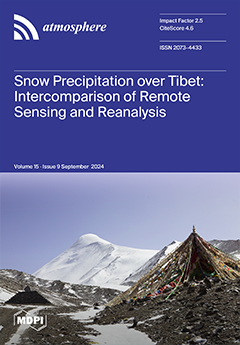The photochemical mechanisms of ozone (O
3) formation are complex, and simply reducing nitrogen oxide (NO
x) emissions is insufficient to reduce O
3 concentrations. The lockdown due to the Coronavirus Disease 2019 (COVID-19) pandemic provided a rare opportunity to explore
[...] Read more.
The photochemical mechanisms of ozone (O
3) formation are complex, and simply reducing nitrogen oxide (NO
x) emissions is insufficient to reduce O
3 concentrations. The lockdown due to the Coronavirus Disease 2019 (COVID-19) pandemic provided a rare opportunity to explore the mechanisms of O
3 formation and evaluate the performance of NO
x emission control strategies through practical observations. This study integrates data from ground stations with observations from the TROPOMI sensor on the Sentinel-5P satellite to analyze air quality changes during the two one-month lockdown periods in Guangzhou, China, in March and November 2022. Our analysis particularly focuses on the impact of these lockdowns on O
3 and NO
2 concentrations, along with shifts in the sensitivity of ozone formation. Furthermore, we have assessed concentration changes of four major pollutants: PM
2.5, PM
10, SO
2, and CO. The results show that the average O
3 concentration in Guangzhou decreased during the March lockdown, while the average O
3 concentration at three stations in the western part of Guangzhou increased during the November lockdown. The western part of Guangzhou is a VOCs (volatile organic compounds)-limited zone, and the NO
2 emission reduction from the lockdown reduced the titration effect on O
3, which led to the increase in O
3 concentration. Overall, the impact of COVID-19 lockdowns on O
3 concentrations depended on the local O
3 producing sensitive system, and emissions of other major pollutants were reduced substantially, as reported in many other cities around the world.
Full article





